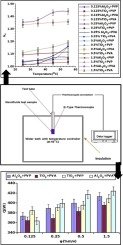Chemical Engineering and Processing: Process Intensification ( IF 4.3 ) Pub Date : 2020-03-03 , DOI: 10.1016/j.cep.2020.107887 Sayantan Mukherjee , Shanta Chakrabarty , Purna Chandra Mishra , Paritosh Chaudhuri

|
This paper aims to provide an experimental investigation on the thermal conductivity enhancement and heat transfer performance of water based Al2O3 and TiO2nanofluids. Nanofluids at different concentrations of 0.125 %, 0.25 %, 0.5 % and 1.5 % of m/V were prepared by two-step method adding Polyvinyl alcohol and Polyvinylpyrrolidone as surfactants. Then, the stability of nanofluids was examined using visual inspection and zeta potential analysis. The thermal conductivity value of test samples was measured using sound velocities in test samples over 25 °C–55 °C for each10 °C rise. Heat transfer performance of nanofluids was examined under transient condition through an experimental setup over 25 °C–60 °C. Stable nanofluids with little sedimentation were obtained. Enhancements in Thermal conductivity and heat transfer performance of nanofluids were achieved. Al2O3 nanofluids have shown the best results with a maximum of 44 % increment in thermal conductivity and a maximum of 21 % increment in transient heat transfer performance. Polyvinylpyrrolidone showed better effect than Polyvinyl alcohol on improving the stability of nanofluids. However, superiority of any surfactant in context of the thermal conductivity and heat transfer performance of nanofluids was ambiguous. Finally, enhanced thermal conductivity and heat transfer performance compared to their basefluids enables them as a potential cooling medium.
中文翻译:

Al 2 O 3-水和TiO 2-水纳米流体的瞬态传热特性和过程强化:实验研究
本文旨在为水基Al 2 O 3和TiO 2的导热系数提高和传热性能提供实验研究。纳米流体。通过添加聚乙烯醇和聚乙烯吡咯烷酮作为表面活性剂的两步法制备了浓度分别为m / V的0.125%,0.25%,0.5%和1.5%的纳米流体。然后,使用目测和ζ电势分析法检查纳米流体的稳定性。对于每升高10°C,使用25°C–55°C以上的测试样品中的声速来测量测试样品的热导率值。通过在25°C–60°C范围内的实验设置,在瞬态条件下检查了纳米流体的传热性能。获得了几乎没有沉淀的稳定的纳米流体。实现了纳米流体的导热率和传热性能的增强。铝2 O 3纳米流体表现出最好的结果,最大导热率增加44%,瞬态传热性能最大增加21%。聚乙烯吡咯烷酮在改善纳米流体的稳定性方面显示出比聚乙烯醇更好的效果。然而,就纳米流体的导热性和传热性能而言,任何表面活性剂的优越性尚不明确。最后,与基础流体相比,增强的导热性和传热性能使其成为潜在的冷却介质。



























 京公网安备 11010802027423号
京公网安备 11010802027423号